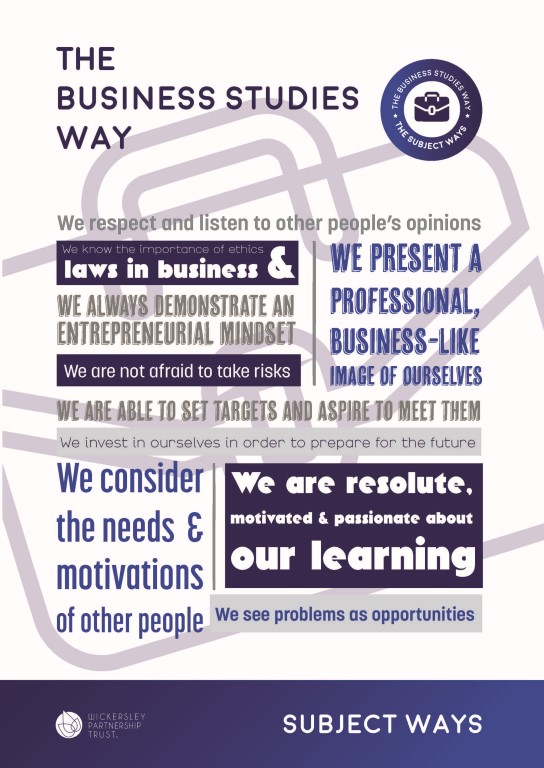Curriculum
Economics
The Subject Way
Our subject has a ‘Subject Way’ at the heart of it. Our Subject Way is designed to help students become young subject specialists. The Subject Way has two main purposes:
Firstly, to teach students the vital skills they need to achieve their full potential and gain the very best grades they can. Secondly, to teach students how each subject relates to the wider world, incorporating the life skills they will learn.
It is our belief that knowing how what you learn links to the wider world brings a subject to life and therefore improves overall understanding and engagement.
Long Term Plans
| YEAR 9 | |||||
| Term 1 | Term 2, Half Term 1 | Term 2, Half Term 2 | Term 3, Half Term 1 | Term 3, Half Term 2 | |
| During Term 1, students are introduced to the new economic terminology and basic concepts that they will study in more depth throughout the GCSE course. They will begin by learning the difference between Microeconomics and Macroeconomics. Students will be able to explain in detail how Economics affects aspects of their daily lives, such as exchanging foreign currency for their holidays and how taxation impacts their family’s disposable income used for their leisure activities and hobbies. | Students will first learn about the nature of economic activity, production, economic choices and the factors of production. On the other side of the course, in macroeconomic, students will be able to calculate interest rates on loans, mortgages and credit cards and understand the consequences of a change in the interest rate. | Students will be introduced to the role of markets, the theory of resource allocation and what specialisation means. Students also get the opportunity to explore government activity, such as the types of taxes and where the government spends their money. | Quantitative skills are introduced into microeconomics this term with calculations on determining prices and the theory of demand and supply as represented by an important diagram. In macroeconomics, students are introduced to the first government objective; economic growth. | Students learn about the different types of goods; such as complements or substitutes in microeconomics. On the other side of the course, unemployment is studied as the second government objective and students learn about the types, causes and costs to the UK. | |
| YEAR 10 | |||||
| Term 1, Half Term 1 | Term 1, Half Term 2 | Term 2, Half Term 1 | Term 2, Half Term 2 | Term 3, Half Term 1 | Term 3, Half Term 2 |
| Students learn how to calculate and interpret price elasticities on demand and supply, as well as studying the final government objectives; inflation and balance of payments. | The next topic in microeconomics is production, costs, revenue and profit which consists of new calculations, diagrams and analysis. On the other side of the course, students explore the distribution of income and wealth in the UK and less developed countries. | Students here will understand the importance of productivity and the theory behind economies of scale. In macroeconomics, students are introduced to the first government policy of fiscal policy. They will learn the meaning of a budget deficit, as well as develop analytical skills to link the policy to each of the government objectives. | Mock revision and feedback. | Students will begin by completing a research project on real-life business to learn about the characteristics of competitive markets and understand how they impact consumers and producers in terms of choice and prices. The final government policies are studied in macroeconomics; monetary policy and supply-side policies. | Students will undertake a micro and macro style project across both sets of lessons. Here students will work for the government and deliver formal presentations on achieving Target 2.0. |
| YEAR 11 | |||||
| Term 1, Half Term 1 | Term 1, Half Term 2 | Term 2, Half Term 1 | Term 2, Half Term 2 | Term 3, Half Term 1 | Term 3, Half Term 2 |
| The causes and consequences of imperfect markets are studied at the beginning of Y11 where students learn about monopolies and oligopolies, as well as how wages are determined in the labour market. International trade is now introduced in macroeconomics, with students learning why trade is important and how the exchange rates are determined. | Mock revision. | The final microeconomic topic is studied; market failure. Here students will learn what market failure is and how the government can intervene. The role of money is studied in macroeconomics. | Students finish learning the market failure topic with an understanding of what externalities are in production and consumption. Macroeconomics concludes with understanding the role of banks, including the purpose of the Bank of England. | Revision | Revision |
Department Staff
N Lilleker
Director
- nlilleker@wickersley.net
C Alecock
E Ashton
Find out more
If you would like more information about our curriculum, please contact the school using the details on our contact page.
Our Subjects at KS4
CORE SUBJECTS
EBACC SUBJECTS
OPTION SUBJECTS




